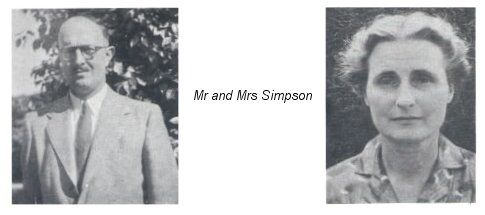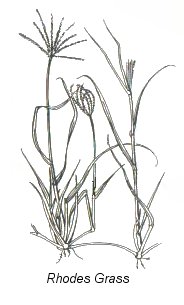In 1948 Melsetter
School
gained a Headmaster who devoted twenty years
to its interests. After frequent changes in Head and staff it was a tremendous
advantage to have some continuity while the School at last developed, and
Melsetter was fortunate in having Jack and Joan Simpson for those years.

The School had 35 pupils, of whom only one was a day pupil. Many of the
children were Social Welfare cases who did not go home for weekends or short
holidays and were very much part of the Simpsons� family. Conditions were
primitive, and Simpson�s earliest preoccupation was with the problem of
sanitation as the removal boys would not make the long walk to the school in bad
weather. His first acquaintance with the V.M.B. Secretary was in this
connection, and the morning phone calls usually began: �Mrs. Allott, the
buckets..." Lighting was by Tilley lamps. The small remote
school was known slightingly as a pumpkin and sadza type, but it was a happy
place and the children were well fed and cared for. Annual fees were �30.
Hostel supplies and mail came twice weekly from Umtali, brought by
persevering and cheerful R.M.S. drivers. When the rains were heavy the road
became impassable and lorries were held up and sometimes perishables had truly
perished, and a ceremonial burial of fish and meat took place. Regular annual
visitors in winter were the Hostels� Supervisor and ibe Government Piano Tuner,
who brought news of the outside world and of other schools and colleagues.
School Inspectors were few, and a difficult journey tended to make them
unappreciative of local assets.

During the third term of each year work began
on the Christmas concert, with the premises a hive of industry as costumes and
properties took shape. Every child took part with great enthusiasm, and
rehearsals took place most afternoons to the accompaniment of torrential rain
drumming on the roof.
The last Saturday of term was an afternoon of magic for the children, and
the whole district turned out in force to see the show and to enjoy the intimacy
of shared jokes which quite unintentionally seemed to apply to members of the
community. Many a young man or woman has returned and been delighted to be
remembered as the Fourth Dwarf, Emperor of China, Rumpelstiltskin, or some other
character, however humble, in a play of years gone by.
Sports Day was originally held in the middle term, but the rigours of
Melsetter winters caused it to be changed to the end of the first term.
Enthusiasm and excitement ran high in the days of preparation. Whatever the
weather, the faithful supporters were always present to cheer and encourage the
children. These functions were followed by a lavish tea supplied by school and
parents and enjoyed by all.
Swimming was much appreciated, and on Mondays the children were
conducted in a croc. to the hotel swimmingbath. Inter-schools sporting fixtures
were limited to those with the nearest neighbours � keen rivalry existed, but
many firm friendships began on the playing fields. Some memorable matches were
played by children against parents, cricket and tennis in summer and soccer and
netball in winter.
Long walks and picnics were very popular. Children loved to know that
they were following an old tradition in enjoying walks to Lonely Tree, Bridal
Veil Falls, Pork Pie, Greenmount and the Pioneer Graveyard, just as their
parents had before them.
Church services were held at regular intervals � Anglican and other
denominations in the Memorial Hall and Dutch Reformed in their own Church.
Church unity was an accepted thing, and all attended whatever service was on
hand. When there was no church service Sunday School was held in a classroom
accompanied by lusty hymn singing, a few special favourites cropping up
regularly.
On Saturday nights everyone donned party clothes and the children
organised their own concerts with a fund of entertaining items. On Sunday
evenings there were gatherings for gramophone records and on weekdays bedtime
reading was popular.
November 5th celebrations were eagerly awaited. During supper Simpson
set the pieces up and the children arrived in warm dressing gowns or blankets to
watch the display. Homemade toffee went the rounds, and after the last and
finest rocket had been duly admired, all trooped in for hot cocoa. Almost as
exciting as the fireworks was the next morning�s Gold Rush: at 6.45 n.m.
everyone lined up, and at a blast of a whistle the Rush began to collect the
debris. It was a triumph to collect a large number, and particularly the biggest
rocket.
Local residents were united in doing their best for the children. Each
Christmas the WI. held a party in the Memorial Hall just before the end of term,
so that the whole school could attend, and it was a very happy function; these
parties for up to 80 children were discontinued in 1959, by when other
organisations were running their own parties and as there were no longer
indigent children at the school the need was no longer there.
Each October the ladies of the Dutch Reformed Church invited the school to
a party: their traditional hospitality was shown to perfection with quantities
of good food, concert items, volkspeletjies, fireworks and singing. There were
also the ceremonies at the Monument on the village green, and the school had a
feeling of being part of history while some of the early settlers were still
here and visited the school.

Melsetter farmers have always done their own experimenting. Conditions
here differ from most of the rest of Rhodesia, and little official interest was
shpwn in helping to find the crops best suited to these conditions. In 1949 the
first Conservation Officer was stationed here, and the Government carried out an
Agro-Economic Survey at the request of the Intensive Conservation Area and Food
Production Committees. The team issued a very full report, summarised in the
Umtali Advertiser by the statement that the time would come when beef production
would give way to smaller intensive holdings of mixed farming, mainly fruit and
dairying, with afforestation of sloping land.
After considerable pressure had been exerted for some years regarding
the need for a research centre, the S.R. Government decided to establish one on
Lindley North, which has a large variation in altitude two main soil types and
an overall easterly aspect. In 1949 the Pasture Research Sub-Station was opened
on 700 acres; during the 1950s the acreage was increased to just over 1 500.
Work on the Station, which throughout its life suffered from insufficient
finance and shortage of staff, centred originally around improved pastures and
dairy cattle and later the emphasis changed to beef cattle and veld management.
Work was also carried out on cash crops grown in rotation with pastures
under test, and a flock of woolled sheep was maintained throughout with work
done on internal parasites in sheep and on various systems of sheep management.
New Zealand Wild White Clover was the proven backbone in the grass/clover
pastures, with Chilean Red Clover its annual counterpart, and latterly Kenyan
White Clover was of interest with Kenyan Red Clover its companion annual. Dahl
and Napier were proved to be of value as fodder crops, and Star and Kikuyu
grasses were outstanding. Burning and mowing experiments were carried out, and
potatoes, wheat and maize all yielded well when used in rotation with pasture
grasses such as Love Grass and Katambora Rhodes.
Milk production on a grass/ clover sward was excellent, but because of
distance from markets the dairying venture was uneconomic. Beef cattle on
pasture gave the most encouraging results, and work had just been started on the
production of beef off the veld when the Eastern Highlands Research Station was
closed in 1965. Overall the Station served an excellent purpose, confirming many
theories and disproving others. Its opening was fully justified, and its closure
was a disappointment to local farmers.
In 1949 several head of cattle died of arsenical poisoning due to the
leakage of dip drums near the Melsetter Trading Company and the area was
immediately dug over and fenced off, but it was strongly felt that the increased
traffic was too much to be handled in one room in Meikle�s building by the
Trading Company as Railways� Agent. Town Planning still held everything up, but
about 1950 the Railway Depot was at last built and Willie Tambwere was placed in
charge.
Dr. Ziervogel retired and was then able to devote his time to farming,
and Dr. Bryce Niblock took over the G.M.O.�s practice.
The National
Parks
Bill was presented in Parliament, and the 20,213
acre Chimanimani and the Wankie National Parks were the first two proclaimed.
Access to the Chimanimani National Park is by road from Melsetter for 15 miles
to the parking place at Dead Cow Camp. A steep path leads up the mountainside,
across a plateau, and down to the Hut. The time for this walk varies from one to
2� hours according to different members of one family; after the long uphill
pull it is disconcerting to find that the hut is only 500� higher than Melsetter
village.
The hut was built with enterprise and hard work: all materials, including
items such as windowpanes, were carried up by relays of carriers and donkeys. In
the impressive stone building everything is on a large and roomy scale, and the
kitchen facilities include gas stoves and paraffin refrigerators; cold showers
and waterborne sanitation have been installed, and overnight accommodation is 7/
6d a head which includes the hire of sleeping bags. From the hut there are
magnificent views down to a plateau with a trout-stocked river winding through
it and across to the backdrop of high peaks. It is an excellent centre for
extensive excursions, and the hut is supplied with maps of the region.
Dr. Rose's services were recognised when he was made an M.B.E., but
rejoicing on his behalf was tempered with sadness when Mrs. Rose died.
Sir Arthur Sims, a prominent New Zealand financier, toured Rhodesia
looking for land, a project in which his daughter Margaret and son-in-law Lewis
Black were particularly interested. In Umtali Binks Holland told him of
Llewellyn�s Ranches, which included Gwendingwe, Brackenbury, Brooklyn and Zebra.
L. C. Meredith had owned these and run cattle on them for many years; he built
the house about 1927, and after his death in 1942 his son Cyril had managed the
estate.
Lewis came out, met Cyril, saw the land, the sheep, the cattle, the
weather conditions, prospects for pine forests, and liked what he saw.
Arrangements were completed for the purchase of Liewellyn�s Ranches, which had
about ten miles of track but no roads, and about 650 sheep and 1 250 head of
cattle, and Philip Hayter took over as Manager of Gwendingwe Estate in June
1949. Soon afterwards Ashbourne was bought from Hanmer Brothers.
Meredith�s bossboy, Matussa, was not kept on by the Company, and he
told Cyril that he had let down his forefathers by selling the property and that
he, Matussa, would see to it that the people who took over never succeeded, and
regularly sent messages saying that the curse would be fulfilled. When Phil was
first there it was lonely, and when he heard movement at night he was certain
that it was old man Meredith cording back to see what was happening, perhaps the
curse being fulfilled. As Phil shifted over in bed there was a shrill peal of
sound from the domestic bell in the kitchen, and he thought that was indeed
Meredith ringing for Matussa � and then discovered that he had pushed the bare
flex against the metal bedhead and caused the ringing himself.
~~~000~~~